The Molybdenum Disilicide Market is estimated to be valued at USD 5.1 billion in 2025 and is projected to reach USD 10.1 billion by 2035, registering a compound annual growth rate (CAGR) of 7.2% over the forecast period.
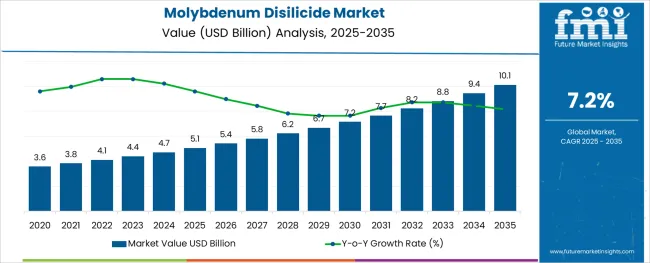
The molybdenum disilicide market is witnessing steady growth driven by the increasing demand for high-performance heating elements capable of operating at elevated temperatures. Industrial sectors requiring durable materials that can withstand harsh environments are adopting molybdenum disilicide for its exceptional thermal stability and oxidation resistance. Applications in industries such as ceramics, metallurgy, and glass manufacturing have contributed significantly to market expansion.
Technological improvements in material processing and coating techniques have enhanced the lifespan and efficiency of molybdenum disilicide products. Growing investments in industrial automation and process optimization have further increased the need for reliable high-temperature components.
The market outlook remains positive as industries continue to seek materials that offer both performance and cost-effectiveness in extreme temperature conditions. Segmental growth is expected to be led by the 1700°C to 1900°C temperature grade, industrial applications, and the technical grade of molybdenum disilicide products.
The market is segmented by Temperature Grade, Application, Grade, and End-use Industry and region. By Temperature Grade, the market is divided into 1700 Deg.–1900 Deg., Up to 1700 Deg., and Above 1900 Deg.. In terms of Application, the market is classified into Industrial and Laboratory. Based on Grade, the market is segmented into Technical, Agriculture, and Pharmaceutical.
By End-use Industry, the market is divided into Steel, Agriculture, Food Processing, Electronics, Glass, Ceramics, and Pharmaceuticals. Regionally, the market is classified into North America, Latin America, Western Europe, Eastern Europe, Balkan & Baltic Countries, Russia & Belarus, Central Asia, East Asia, South Asia & Pacific, and the Middle East & Africa.
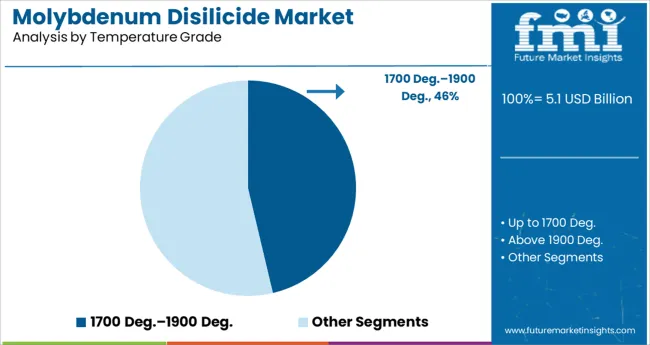
The 1700°C to 1900°C temperature grade segment is projected to contribute 46.3% of the molybdenum disilicide market revenue in 2025, maintaining its leadership among temperature classifications. This segment’s growth is due to the wide range of industrial processes that operate within this temperature window, requiring heating elements that can sustain performance without degradation. Molybdenum disilicide products in this grade offer the ideal balance of thermal conductivity and oxidation resistance needed for consistent operation.
Industries involved in high-temperature sintering, annealing, and glass melting frequently rely on this grade for reliable heating solutions.
As demand for energy-efficient and durable heating elements rises, the 1700°C to 1900°C grade is expected to remain essential in industrial thermal applications.
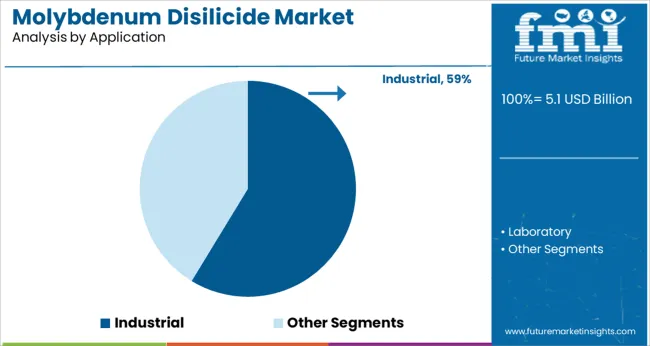
The industrial application segment is forecasted to hold 58.7% of the molybdenum disilicide market revenue in 2025, asserting its position as the dominant end-use category. Growth in this segment is driven by expanding manufacturing activities and the increasing complexity of industrial processes that require precise temperature control. Molybdenum disilicide heating elements are valued for their long operational life and resistance to corrosive atmospheres common in industrial settings.
Industries such as electronics manufacturing, chemical processing, and metal treatment have increasingly adopted molybdenum disilicide components to improve efficiency and product quality.
The need for robust materials capable of withstanding extreme conditions continues to fuel demand in this sector. This segment is poised to maintain its market leadership as industrial innovation progresses.
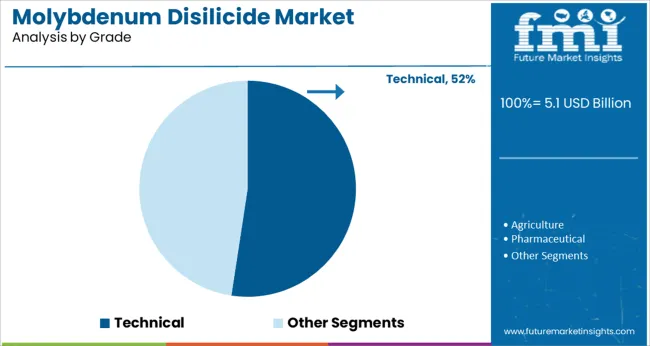
The technical grade segment is projected to account for 52.4% of the molybdenum disilicide market revenue in 2025, securing its status as the leading product grade. This segment’s expansion is supported by the demand for high-purity materials with consistent physical and chemical properties necessary for precision applications. Technical grade molybdenum disilicide is preferred in processes requiring strict quality standards, such as semiconductor manufacturing and specialized coating applications.
The material’s ability to maintain structural integrity under prolonged exposure to extreme heat makes it a preferred choice among manufacturers.
Increased focus on material performance and reliability has led to wider adoption of technical grade products in advanced industrial processes. The segment is expected to continue driving market growth due to its critical role in high-temperature applications.
Surging use of molybdenum disilicide in refractory furnaces is one of the crucial factors that is anticipated to augment the market. Rapid expansion of the automotive sector with the rising demand for electric vehicles worldwide is set to provide traction for vehicle manufacturing materials, including glass, iron, and steel.
With the introduction of stringent norms by government agencies to prevent emissions of carbon in the atmosphere, vehicle manufacturers are using high-strength and lightweight steel components. Increasing adoption of novel steel components by the automotive industry worldwide is expected to boost demand for refectory furnaces, thereby pushing the global molybdenum disilicide market growth in the assessment period.
Manufacturing of refractory materials is a highly carbon-intensive process as it contains various steps such as curing, baking, and mining materials. Large amounts of carbon dioxide and numerous pollutants, including volatile organic compounds and carbon monoxide are emitted in the atmosphere during production processes.
Governments of various countries are set to put forward strict norms to regulate the release of such toxic gases in the atmosphere. Thus, refractory manufacturers are expected to reduce their carbon intensity, which may lead to lower margins. The above-mentioned restrictions can hamper sales of molybdenum disilicide in the evaluation period.
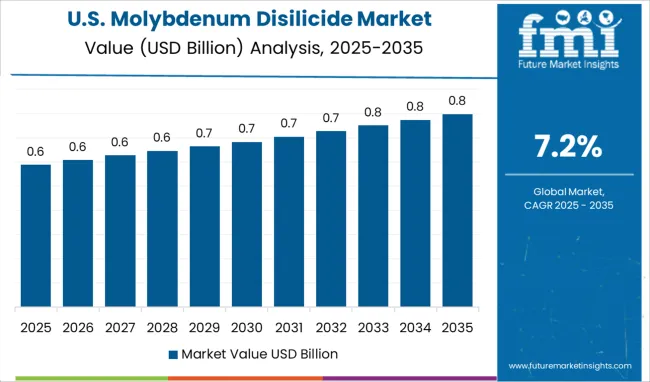
In terms of molybdenum disilicide market share, North America is estimated to dominate throughout the forecast period. Introduction of advanced glass melting technology across the USA and Canada is anticipated to spur growth. Building a glass furnace depends on the selection of refractory materials as the furnace’s operating period relies directly on the quality of refractories.
Presence of a well-established cement manufacturing industry in North America is also set to aid the regional market. Good quality refractory solutions help in surging the efficiency of cement manufacturing processes. Increasing use of refractory bricks in rotary kilns in the cement manufacturing industry is projected to drive the North America market.
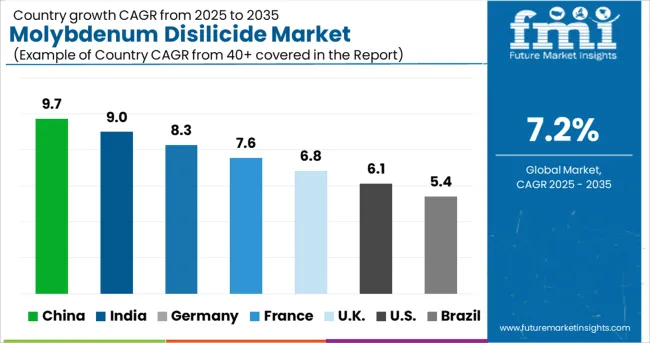
In Asia Pacific, demand for molybdenum disilicide is anticipated to grow in the assessment period on the back of expansion of the iron and steel industry in India and China. As per the India Brand Equity Foundation (IBEF), India was the world’s second-largest producer of crude steel with an approximate output of 9.8 MT as of October 2024.
Easy availability of raw materials and affordable labor is set to propel the steel sector, thereby driving the regional market. Besides, expansion of the petrochemical industry is expected to push the need for specialized refractory materials, which would create new growth opportunities for key players across Asia Pacific.

Some of the leading companies present in the global molybdenum disilicide market include Zhengzhou Chida, I Squared R, Yantai Torch, American Elements, Shanghai Caixing, MHI, ZIRCAR, SCHUPP, and Kanthal among others.
The majority of the renowned companies are focusing on expanding their manufacturing facilities, especially in untapped regions to cater to the ever-increasing demand from end-use industries. They are also aiming to engage in mergers and acquisitions with local companies to co-develop novel products and gain access to the latter’s innovative technologies.
| Report Attribute | Details |
|---|---|
| Expected Market Value (2025) | USD 4.1 Billion |
| Market Forecast Value (2035) | USD 8.5 Billion |
| Growth Rate | CAGR of 7.2% from 2025 to 2035 |
| Base Year for Estimation | 2024 |
| Historical Data | 2020 to 2024 |
| Forecast Period | 2025 to 2035 |
| Quantitative Units | Revenue in million and CAGR from 2025 to 2035 |
| Report Coverage | Revenue Forecast, Volume Forecast, Company Ranking, Competitive Landscape, Growth Factors, Trends and Pricing Analysis |
| Segments Covered | Temperature Grade, Application, Grade, End-use Industry, Region |
| Regions Covered | North America; Latin America; Western Europe; Eastern Europe; APEJ; Japan; Middle East and Africa |
| Key Countries Profiled | USA., Canada, Brazil, Argentina, Germany, UK, France, Spain, Italy, Nordics, BENELUX, Australia & New Zealand, China, India, ASEAN, GCC, South Africa |
| Key Companies Profiled | Zhengzhou Chida; I Squared R; Yantai Torch; American Elements; Shanghai Caixing; MHI; ZIRCAR; SCHUPP; Kanthal |
| Customization | Available Upon Request |
The global molybdenum disilicide market is estimated to be valued at USD 5.1 billion in 2025.
It is projected to reach USD 10.1 billion by 2035.
The market is expected to grow at a 7.2% CAGR between 2025 and 2035.
The key product types are 1700 deg.–1900 deg., up to 1700 deg. and above 1900 deg..
industrial segment is expected to dominate with a 58.7% industry share in 2025.






Full Research Suite comprises of:
Market outlook & trends analysis
Interviews & case studies
Strategic recommendations
Vendor profiles & capabilities analysis
5-year forecasts
8 regions and 60+ country-level data splits
Market segment data splits
12 months of continuous data updates
DELIVERED AS:
PDF EXCEL ONLINE
Molybdenum Disulfide Dry Film Lubricant Market Forecast and Outlook 2025 to 2035
Molybdenum Disulfide (MoS2) Crystal Market Size and Share Forecast Outlook 2025 to 2035
Molybdenum-99 Market Size, Share, and Forecast 2025 to 2035
Molybdenum Market Insights – Size, Share & Industry Growth 2025 to 2035
Molybdenum Cofactor Deficiency Type-A (MoCoD-A) Treatment Market Analysis by Drug Class, Route of Administration, Distribution Channel, and Region through 2025 to 2035
Molybdenum Disulfide Market

Thank you!
You will receive an email from our Business Development Manager. Please be sure to check your SPAM/JUNK folder too.
Chat With
MaRIA